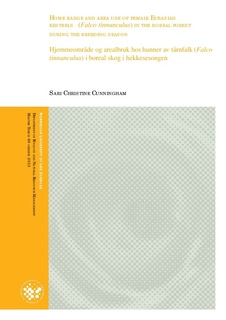| dc.description.abstract | I studied home range and area use of the female Eurasian kestrel (Falco tinnunculus), in the boreal forested area of Trysil municipality (61°00' - 61°41'N, 11°44' - 12°52'E) in the breeding season of 2011, a peak vole year. Six females were tagged and radio-tracked using VHF telemetry in the pre-fledging period, and two of these females were additionally followed in the early post-fledge period. Females were located between 49 and 141 times in the pre-fledging period ( χ = 98 ± 13 SE), totaling 589 observations, which allowed the investigation of area use questions using the Minimum Convex Polygon (MCP) and fixed kernel href methods. I found a large variation in home range size between females as measured by the overall 100% MCP (range 0.69 - 6.16 km2, median = 0.94 km2, χ = 1.84 ± 0.87 SE km2), and in the levels to which each home range was centered on the nest. Home range size was significantly positively correlated with the proportion of bog with forest (overall 95% kernel) and the proportion of forest of developmental stage 3 present (overall 95% kernel, and overall 100% MCP), and significantly negatively correlated with proportion of pooled developmental stage 4 and 5 (overall 95% kernel). A trend approaching significance was found for negative correlation with Microtus vole abundance (overall 95% kernel). A higher probability of being in the core foraging area (foraging 50% kernel) was associated with decreased distance to nest and decreased distance to bog, highlighting the importance of maintaining proximity to the nest site for the kestrel as a central-place forager, and the importance of proximity to open habitat. In addition, post-fledge tracking highlighted the importance of the nest in the early fledging period. My results indicate the importance of taking into account vegetation structure and how it relates to prey availability, when looking at the effect on home range size. I further suggest that the role of modern forestry practices should be investigated, with regards to the effects habitat fragmentation and patch size and shape may play on spatial and temporal area use by the female kestrel in boreal forest. | |

